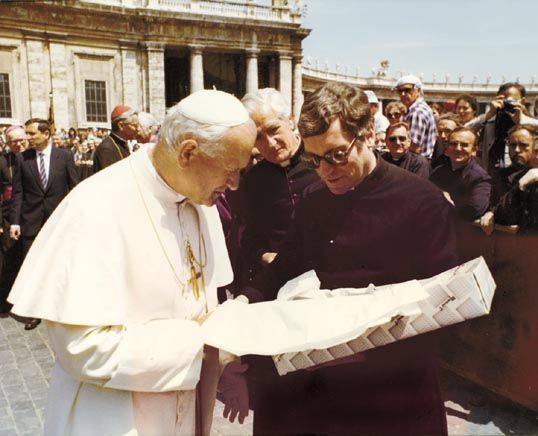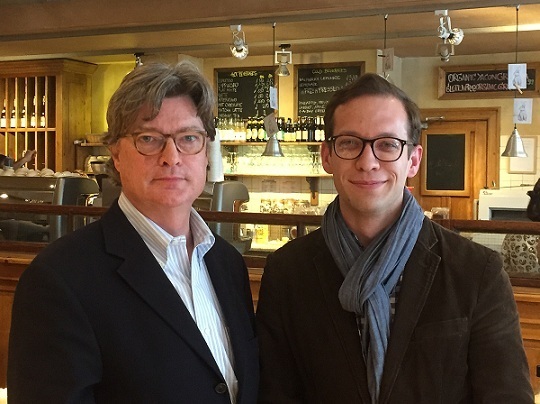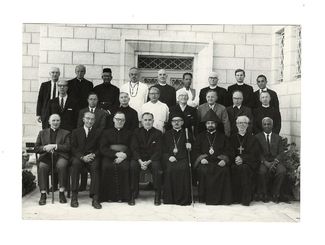
Christopher R. Brewer (PhD, St And) is a Program Officer of the Templeton Religion Trust in Nassau, The Bahamas. He is the editor or co-editor of six volumes including Christian Theology and the Transformation of Natural Religion: From Incarnation to Sacramentality––Essays in Honour of David Brown (Peeters, 2018). After completing a BA in Bible (2001), an MA in Historical Theology (2004) and an MDiv (2010), he moved, together with his wife and two boys, to St Andrews, Scotland where he completed a PhD under the supervision of the Revd Professor David Brown in the Institute for Theology, Imagination and the Arts at St Mary’s College, University of St Andrews (2015). His doctoral thesis was focused on Canon Howard Root; a significant figure in the early years of Tantur Ecumenical Institute. Dr. Christopher Brewer was gracious enough to provide Tantur with an interview regarding his research on this important ecumenical personality.
Your doctoral thesis focuses on Canon Howard Root, a leading ecumenical figure within the Anglican Church, specifically with relations with the Catholic Church. Could you provide a brief overview to Canon Root?
Dr. Brewer: A significant though oft neglected figure in the recent history of British Christianity, Root was born in Oak Park, IL (USA) in 1926. He went on to attend the University of Southern California, where, after graduating in 1945, he was a Teaching Fellow for two years before moving to Egypt where he was Lecturer in Philosophy and Comparative Religion at the American University in Cairo. Under the influence of Geoffrey Allen, the Anglican Bishop in Egypt, Root then moved to England where he matriculated at Oxford as a member of St Catherine’s Society and read for the Honour School of Theology. He completed his B.A. in 1951, and after this sought ordination, but Thomas Boase, then President of Magdalen, as well as Kenneth Kirk, Regius Professor of Moral and Pastoral Theology and the Bishop of Oxford, encouraged him to “concentrate on philosophy” instead, noting that “it is very important that one or two of the younger clergy should be able to get to grips with modern philosophic thought.” Root followed this advice, and his concentration along these lines led to Senior Demy research with the philosopher Gilbert Ryle (1900–76).
Root’s Senior Demy research had to do with the possibility of a logic of theological language. That said, Root relinquished this Senior Demyship, effective 30 September 1953, to take up the post of Assistant Lecturer in Divinity at Cambridge with effect from 1 October 1953. He was ordained deacon in that same year, and then ordained priest in 1954. He became Chaplain of Emmanuel College, Cambridge in that same year, a position which he held through 1956 when he became Dean of the same. It was in that year that Root published a critical edition of David Hume’s The Natural History of Religion. He then became Lecturer in Divinity, University of Cambridge in 1957. In that same year, he applied for, and was elected, Wilde Lecturer in Natural and Comparative Religion (1957–60) at the University of Oxford. Up until this time, and for several years after, Root’s efforts continued along what might be called a metaphysical trajectory, his publications having primarily to do with metaphysics (1961) and natural theology (1962).
In a letter dated 28 May 1963, however, Root was asked by Archbishop Michael Ramsey “to be an Observer at the Vatican Council for some time between its resumption in September and Christmas.” Though he had attended the Anglican/Roman Catholic meetings in Assisi (April 1961) and Oxford (1962), Vatican II had a decisive influence upon Root. From that point on, Root’s efforts tended towards ecumenical engagement. He was an observer – the youngest official Anglican observer – at the second and third sessions.
Root became the first Professor of Theology at the University of Southampton and Honorary Chaplain at Winchester Cathedral in 1966. In that same year, he was asked to serve on the Anglican-Roman Catholic Joint Preparatory Commission. He then served as Chairman on the Archbishop’s Commission on Marriage (1968–71), the Academic Council of the Ecumenical Institute for Advanced Theological Studies, Tantur as well as the Anglican-Roman Catholic International Commission (1970–81). As previously noted, he delivered the Bampton Lectures in 1972. In 1979, Root was appointed Pope Adrian VI Professor at the University of Louvain. Then, in 1981, he was appointed Director of the Anglican Centre, Rome. In 1984, he became visiting Professor at the Gregorian University in Rome. He was also a fellow of the Pontifical International Marian Academy in Rome as well as a member of the Institute of Pope Paul VI at Brescia, Italy. Root retired in 1991, and died in 2007.
What was your decision, or perhaps motivation, to focus your doctoral thesis on Canon Root?
Dr. Brewer: My research had to do with the possibility of a natural theology of the arts, and, as I was researching the rich diversity of natural theologies, I came across, rather serendipitously, an unpublished essay by Peter Barrett in which he makes passing reference to Root’s 1962 essay, “Beginning All Over Again,” an essay in which Root calls for the resourcing of natural theology via the arts. Shortly thereafter, I read Root’s obituary in The Telegraph and learned that he had in 1972 delivered the Bampton Lectures. Fascinated, and wanting to know more, I began to search for Root’s lectures in the hopes that they might shed additional light on his 1962 essay. According to the will of John Bampton (1690–1751), “thirty copies of the eight Divinity Lectures shall be always printed, within two months after they are preached; and one copy shall be given to the Chancellor of the University, and one copy to the Head of every College, and one copy to the mayor of the city of Oxford, and one copy to be put into the Bodleian Library.” Root’s lectures, however, were never printed or distributed, and much to their surprise, the Bodleian Library had no record of the lectures when I contacted them in April 2014. Additional research led me to the Lambeth Palace Library where Root’s archives are kept. According to their online database, there were five boxes of uncatalogued material not necessarily available for research. Hope against hope, I emailed asking if the library staff might be willing to look through the boxes and was pleasantly surprised when I was informed that Root’s 1972 Bampton Lectures, “The Limits of Radicalism,” had been located. There were two full manuscripts, and so the library offered to send one of the original manuscripts to me. I’ve since returned them, but, when I received them, I knew that I had stumbled upon something significant. It’s such a rare opportunity to discover and work on something not yet worked on, and I’ve found Root’s life and work fascinating throughout.
Canon Root had an active connection to Tantur from its early years to the late 1970s. Could you outline his contributions to Tantur as you understand them?
Dr. Brewer: It goes without saying that Vatican II was significant, and this for a variety of reasons, but it was particularly significant for Root. In a letter from Root to Ramsey dated 27 November 1963, Root said: “I shall always be grateful to you for the opportunity to observe the Council.” Then, in his 1964 essay, “Observing Vatican II,” Root speaks of “this privilege of indirect participation in the Council.” Root’s participation in, and loyalty to, the Council led to additional opportunities. In a letter dated 30 June 1966 from Ramsey to Root, Ramsey noted: “My requests for your help seem to multiply, but here is a request which I have a very particular reason for making, namely your experience as an Observer at the Vatican Council.” In another letter, Root noted: “Ever since you asked me, in 1963, to be one of the Observers at the Vatican Council I have become more and more intimately concerned with this particular part of our ecumenical task.” It is clear, then, that Root’s service as an Observer at the Second Vatican Council was not only significant, but led to a number of other opportunities including serving on the Joint Preparatory Commission, the Permanent Joint Commission, and – to return to your question – the academic council for the ecumenical institute. Each of these was a direct result of Vatican II, and Root’s participation in each of these was a direct result of his participation at Vatican II.
That said, Root attended numerous meetings of the academic council from 1966 until the institute’s opening in October 1971. The brochure points out that the Ecumenical Institute “grew out of a suggestion for an ecumenical study of salvation history, made to Pope Paul VI by non-Catholic observers at Vatican II.” With that in mind, Root’s contributions to Tantur preceded the early years for, as a non-Catholic observer, Root may very well have had a hand in planting the seed which he later watered and harvested. In other words, without Root and the other non-Catholic observers, the institute may well have never been. For those wanting more specific, day-to-day details, Root’s reports from his trips to Jerusalem, as well as numerous letters, are available at Lambeth Palace Library, London (Manuscripts and Archives, CFR RC 16/1). It should also be noted that two of Root’s lectures were published, and so are accessible, in the Tantur Yearbook.
What do you think is the legacy of Canon Root in ecumenical Christian concerns? What further academic work can be done to further this legacy?
Dr. Brewer: His legacy should primarily be understood in terms of his participation in the Second Vatican Council and, perhaps more importantly, in terms of the British reception of the Council. Root, it seems to me, had less of a demonstrable impact upon the Council than the Council had upon Root. This might be explained in a number of ways, but I suspect that Root having been the youngest of the Anglican Observers might have had something to do with it. But that is also what makes him fascinating. He was not only, as a non-Catholic observer, an outsider, but he was, even within that group I think, an outlier. In any case, Root’s legacy amounts to a sustained and personal dialogue that continued for nearly half a century. It began at, if not before, the Anglican/Roman Catholic meeting in Assisi in April 1961, and continued through the Council, ARCIC, Tantur, the Anglican Centre in Rome and beyond, i.e. until Root’s death in 2007.
A 2002 interview with Phillippa Hitchen on “Radio Vaticana – Hear All About It” provides additional perspective. Towards the end of that interview Root said: “I mean, there are a number of people these days that think that the shine is off, as it were, that we’re … I heard someone say quite recently, you know, those days were spring and now it look as though we’re coming back to winter. I think maybe we don’t quite feel that, but, to some extent, these things go by the seasons. I remember the famous Cardinal Siri of Genoa who was not, shall we say, one of those most enthusiastic about the Second Vatican Council, said it was going to take the Church a hundred years to get over it. Put it in another way, say it is going to take a hundred years to see what the consequences were in fact going to be, and I think that’s probably not unrealistic, really.” But Root didn’t wait to see what the consequences were going to be, but instead, actively sought to work them out over the course of nearly fifty years.
Also worth noting here is that ecumenism and dialogue were, for Root, personal rather than abstract. This is explicit in “The Theological Basis of Interfaith Dialogue” (Tantur Yearbook 1975/76, 85–97), a lecture/essay in which Root argues that while dialogue is officially taking place between abstractions (i.e., Rome and Canterbury), it is in reality taking place between persons. And here comes Root’s challenge to the listener/reader. He suggests that “many brought up in the Christian faith and professing belief (of some sort) in its dogma and doctrine can hold the naive belief that ‘Tomorrow I will engage in genuine, authentic dialogue’. Tomorrow, or better still, today they can begin their apprenticeship. And to that degree they will be beginning to do the thing for which they are training. Not terribly well, probably pretty ineffectively, but doing it nonetheless. And, most importantly, not in a random, individualistic, anarchic way, but in a disciplined way, in obedience and under authority.” Dialogue was, for Root, personal and necessary. It was, in other words, essential for the listener/reader (i.e., you and me), and here Root meant to include interfaith as well as ecumenical dialogue. From this perspective, practice might need to precede further academic work. That said, with reference to further academic work, academics might turn their attention to Root’s reception of the Second Vatican Council – in dialogue with the work of T.S. Eliot, Graham Greene and others – as one particular example of ecumenical Christian concern.
What are your present plans for further theological studies or research?
Dr. Brewer: Having just edited a critical edition of Root’s 1972 Bampton Lectures––Theological Radicalism and Tradition: ‘The Limits of Radicalism’ with Appendices (Routledge, 2018)––I am now working on a second Root volume provisionally titled Anglican Ecumenism: Reflections on a Vatican II Observer. If all goes according to plan, that volume should be available early 2020. In the meantime, I am writing a book for Zondervan Academic, an expansion of the first chapter of my doctoral thesis. It’s titled Understanding Natural Theology, and presents a five-type taxonomy of natural theology.
Will your thesis be available to the public as a published work?
Dr. Brewer: The first chapter will be available in expanded form, and the second chapter (on Root) has been used for the introduction to Theological Radicalism and Tradition. Some of the material from the third chapter (on William Desmond) appears in William Desmond and Contemporary Theology (UNDP, 2017), and I wrote a new essay based upon the research for my fourth chapter for inclusion in The Moving Text: Interdisciplinary Perspectives on David Brown and the Bible (SCM Press, 2018). That said, I plan to use the thesis, which I consider to be something like polished research notes, to write the book I’ve wanted to write all along. The working title for that book is (Un)natural Theology, and has to do primarily with, as Root put it, “Beginning All Over Again”. In that 1962 essay, Root wrote: “Our thinking is still confined to the familiar grooves: natural and revealed; reason and faith. It may seem paradoxical, but there would be point in saying that a restoration of natural theology will finally depend upon the abandonment of our present understanding of what it is.” I think this means not only getting beyond the either/or of natural/revealed, but also the either/or of pre-dogmatic/dogmatic natural theology. The categories of pre-dogmatic and dogmatic natural theology are no longer sufficient. What is needed, it seems to me, is natural theology as post-dogmatic recovery, and here I’m thinking of Desmond’s “second perplexity” and “second astonishment” beyond “criticism”, or Richard Kearney’s notion of “anatheism”. Put simply: natural theology today has (or should have) less to do with reasons to believe than with imagining the possibility of believing again. And here again like Root, I think the arts particularly relevant to the conversation.
Article photo of Canon Howard Root with Pope John Paul II from Church Times. Photo of Canon Howard Root at Tantur ctsy Root Family via Dr. Brewer. Canon Howard Root can be seen back row, second from right. UND President Fr. Ted Hesburgh is front row, center.

Christopher R. Brewer, PhD (St And) is pictured here (r) with Anthony Root, son of Canon Howard Root. Dr. Brewer can be reached at cbrewer@templetonreligiontrust.org.
- Garrick V. Allen, Christopher R. Brewer and Dennis F. Kinlaw III, eds. The Moving Text: Interdisciplinary Perspectives on David Brown and the Bible
- Christopher R. Brewer, ed. Christian Theology and the Transformation of Natural Religion: From Incarnation to Sacramentality––Essays in Honour of David Brown
- Howard E. Root, Theological Radicalism and Tradition: 'The Limits of Radicalism' with Appendices, ed. Christopher R. Brewer
- David Brown, Divine Generosity and Human Creativity: Theology through Symbol, Painting and Architecture, ed. Christopher R. Brewer and Robert MacSwain
- David Brown, God in a Single Vision: Integrating Philosophy and Theology, ed. Christopher R. Brewer and Robert MacSwain
